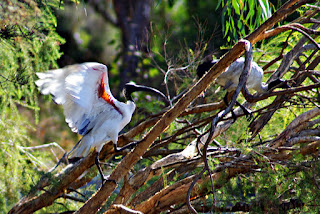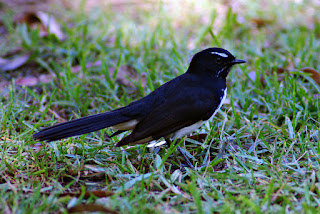Sunday, 17 March 2013
Common Bronzewing
The Common Bronzewing is the species of pigeons. This bird is named for its beautiful iridescent bronze coloured wing feathers.
Photos taken 1, Point Heathcote reserve, Perth
Navadni Bronasti krilec spada v vrsto golobov. Ptica je dobila ime zaradi čudovitega spreminjajoče bronastega perja na krilih.
Rainbow Lorikeet
This is one of Australian most colourful parrots. Its noisy and can become tame enough to hand feed.
Although usually moving about in small flocks, hundreds sometimes feed with their brush-like tongue on the blossom nectar of shurbs and trees.
In Australia lives 52 species of parrots.
Photos taken 1,2,3,4, Point Walter reserve, Perth W.A.
Je ena najbolj pisanih avstralskih papig. Je zelo glasna in dovolj krotka, da jo je mogoče hraniti iz roke.
Čeprav jih ponavadi vidimo v manjših jatah se jih včasih v drevesih na stotine hrani, z kot ščet oblikovanimi jeziki z cvetnim nektarjem.
V Avstraliji živi 52 vrst papig.
Brown honeyeater
There are 3 subspacies troughout Australia, but only one in Western Australia. A small honeyeater, highly active and very common in the Perth region. Most diverse in its choice of feeding habitats including wet sclerophyll forests, mangroves, dry arid woodland and heath.
Its all the time busy acrobatic bird, frequently on the wing, hovering over flowers and pursuing insects on the flight.
A lot of people said that is the best songster among Australian birds. It has a clear rolling musical call, which is very loud for the size of the bird.
Photos taken 1,2, Point Heathcote, Perth W.A.
Monday, 11 March 2013
Pacific Black Duck
Like other ducks and geese, this very common Australian duck is a strong swimmer. It most fund near the water and normally feeds on aquatic plant seeds, insects, and crustaceans, but is also accused by farmers of damaging crops.
More brown then black, it has a dark line edged in white from the bill, trough to the eye.
Photos taken, 1,2, Tomato Lake, Perth W.A. 3,4 Herdsman Lake
Osprey
This bird of prey is commonly observed along the coast, on the margins of rivers, and on offshore islands.
Despite a similar appearance, it's only distantly related to the eagles, hawks and kites.
Its diet consist almost exclusively of fish, which is grasps with its talons from the water during flight.
Ospreys possess a number of unique adaptations, including a closable nostril, a riversible outer toe, and spines under the foot.
They build large stick nests high on rocky headlands, in trees, or on electricity transmission towers.
Photos taken, 1,2, Point Heathcote reserve. Perth W.A.
Australian Shelduck
The Australian Shelduck breeds in Southern Australia and Tasmania. In the winter many birds move further north than the breeding range.
As with other shelducks, the species has favorite moulting grounds, such as lake George in New South Wales, where sizeable concentrations occur.
The Australian Shelduck's primary habitat is lakes in fairly open country. It makes its nest in three holes in banks or similar location.
Photos taken 1, Tomato Lake, Perth W.A.
Great Cormorant
Cormorants are persecuted by some fishers due to their proficiency in catching fish.
They can distort the lenses in their ayes and thus see well both above and below water.
This one inhabits most coastal and inland waterways.
The wings lack waterproofing, reducing buoyancy and helping the bird to reach the riverbed to feed.
Photos taken 1,2 Swan river, Queen Elizabeth quay.
Sunday, 10 March 2013
Black Swan
The Black Swan is national bird of Western Australia and emblem on the W.A. flag.
This large bird has a long slender neck, a red bill and black plumage but with white wing tips that are noticeable during flight.
After the breeding season, thousands of Swans gather in wetlands, feeding on aquatic plants and marsh grasses.
Their distinctive trumpeting call is sometimes heard when they are flying in a V formation at night.
Photos taken 1,2,3,4,5,6, Swan River, Victoria park, Perth W.A.
Magpie lark
This bird is concpicuous Australian bird of small to medium size, also known as the Mudlark in Western Australia and Victoria, the Murray magpie in South Australia, and as the Peewee in New South Wales and Queensland.
It spends most of time foraging for insects on the ground.
Photos taken 1,2, Tomato lake, Perth W.A.
Australian Pelican
In addition to coastal lagoons, this bird can be found almost anywhere in Australia where sufficient water exist to support fish and crustaceans.
It's easily identifiable, whether soaring in the air, or floating on water.
Pelicans like a free feed and often wait for handouts near boat ramps.
Photos taken 1,2, Swan river, Belmont. W.A. 3,4,5 Penguin Island
Australian Raven
Last updates:
02.07.2014. photo 4,5.
The Australian Raven is one of five Australian species commonly knows as crows. It is a more slender bird then the Common Raven, but is otherwise simmilar.
The birds can be found in wide range of natural and modified habitats. It requires available water and trees to roost in or perch on. Preferred habitats include eucalypt-dominated sclerophyll forests, and farmland adjacant to trees.
In rural areas a single breading pair and their brood will occupy about a square kilometre territory, whilst in in urban areas over ten times as many ravens can cearch for food in the same square kilometras.
Food consist of carrion, insects, seeds, small reptiles, nestlings and eggs.
The Australian Raven is frequently blamed for the loss of young lambs.
Photo: Jozef Skubin. 1,2, Victoria Park, Perth W.A. 3, Point heathcote reserve.
4,5, Walter Point 29.03.2014
African Sacred Ibis
The bird has been introduced from Africa.
The bald head and neck, thick curved bill and legs are black. The white wings show a black rear border in flight.
Its feeds on various, fish, frogs,small mammals and insects, as well as smaller birds.
More common in Australia is Straw-necked Ibis its colors are oposites, black body and wings and white neck.
The African Sacred Ibis has been often mummified by ancient Egyptians as a symbol of the God Thoth. It's seen in Egyptians hyroglifies.
Photos taken 1,2, Tomato Lake Perth W.A. 3 Herdmann lake
Saturday, 9 March 2013
Purple Swamp Hen
Also known locally as the Pukeko, African Purple Swamphen, Purple Moorhen.
This chicken size bird with its huge feet, bring plumage, red bill and frontal shield is easily recognisible in its native range.
But there are 13 or more subspecies of Purple Swamphen.
The species prefers wet areas with high rainfall, swamps, lake edges and dump pastures.
The birds often lives in pairs and larger comunities.
It clambers trough the reeds, eating the tender shots and vegetables like matter. They have been known to eat eggs, duckling and small fish.
They use one of its huge foot to bring food to their mouth.
Photos taken 1,2,3, Tomato lake, Perth W.A.
Willie Wagtail
One of the most common birds in urban areas across Australia, this black and white fantail is usually observed singly or in pairs.
It moves constantly in search of insects, worms, spiders and flies, whilst wagging its tail and maintaining a constant repetitive chatter of "sweet pretty creature".
It is one of the most easily approached Australian birds.
Photos taken 1,2, Tomato Lake, Perth W.A.
Red wattlebird
The Red Wattlebird also known as Barkingbird or Gillbird is a large, noisy honeyeater. Is among the largest of the Australian honeyeaters. The common name refers to the fleshy reddish wattle on the side of the neck.
The wattles are used for compressing nectar from the flowers, when the bill is closed.
The plumage is gray-brown on the body, with prominent white streaks and yellow on the belly. The face is pale and the tail is long whit a white-tip.
Young Red Wattlebirds are duller then the adult and have a brown, rather then reddish, aye. The wattle is also very small and pale.
Its main food is nectar, which is obtains by probing flowers with its thin curved bill. Some insects are also eaten, taken either from foliage or caught in mid-air. Berries and the honeydew produced by some insects add to the bird's diet.
Its range extends throughout the southern areas of the Australian mainland and occurs in forests and woodlands, where it aggressively protect food-bearing plants from the other honeyeater species.
Photos taken 1,2,3,4, Tomato lake, Perth W.A.
5,6 Withman national park W.A. 7 Herdsman Lake
Red Wattlebird je pogosto znan pod imenom Barkingbird ali lajajoč ptič zaradi njegovega značilnega oglašanja. Je zelo glasna ptica vrste medojedcev in je ena izmed največjih, te vrste. Ime se nanaša na mesnata, rdečkasta jezička, ki jim visita ob straneh vrata in služita za stiskanje medu iz cveta kadar je kljun zaprt.
Po večjem delu telesa je perje sivo-rjavo, z vidnimi belimi progami in rumeno po trebuhu. Ima bled obraz in dolg rep z belimi odtenki na koncu.
Perje mladičev je bolj pustih barv kot odraslih ptičev, oči pa imajo pogosteje rjave kot rdečkaste. Prav tako imajo zelo blede in majne jezičke na vratu.
V glavnem se prehranjujejo z cvetnim nektarjem katerega črpa iz cvetov z rahlo ukrivljenim tenkim kljunom in nekaterimi insekti ki jih najde na listju ali ulovi v zraku. Na jedilniku pa so tudi gozdne jagode in ostanki medu drugih insektov.
Njegov habitat sega čez vsa južna področja Avstralske celine, nahaja pa se v gozdovih in širših gozdnih pokrajinah, kjer agresivno brani svoje položaje s hrano pred drugimi medojedimi vrstami.
Subscribe to:
Comments (Atom)


















































